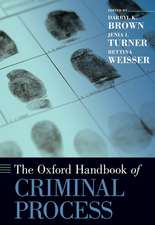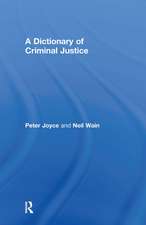Handbook of Restorative Justice
Editat de Gerry Johnstone, Daniel Van Nessen Limba Engleză Paperback – oct 2006
This book aims to meet the need for a comprehensive, reliable and accessible overview of the subject. It draws together leading authorities on the subject from around the world in order to:
- elucidate and discuss the key concepts and principles of restorative justice
- explain how the campaign for restorative justice arose and developed into the influential social movement it is today
- describe the variety of restorative justice practices, explain how they have developed in various places and contexts, and critically examine their rationales and effects
- identify and examine key tensions and issues within the restorative justice movement
- brings a variety of disciplinary and interdisciplinary perspectives to bear upon the understanding and assessment of restorative justice.
| Toate formatele și edițiile | Preț | Express |
|---|---|---|
| Paperback (1) | 517.65 lei 6-8 săpt. | |
| Taylor & Francis – oct 2006 | 517.65 lei 6-8 săpt. | |
| Hardback (1) | 1033.22 lei 6-8 săpt. | |
| Taylor & Francis – oct 2006 | 1033.22 lei 6-8 săpt. |
Preț: 517.65 lei
Preț vechi: 609.00 lei
-15% Nou
Puncte Express: 776
Preț estimativ în valută:
99.07€ • 102.55$ • 83.73£
99.07€ • 102.55$ • 83.73£
Carte tipărită la comandă
Livrare economică 05-19 martie
Preluare comenzi: 021 569.72.76
Specificații
ISBN-13: 9781843921509
ISBN-10: 1843921502
Pagini: 672
Ilustrații: Illustrations
Dimensiuni: 174 x 246 x 43 mm
Greutate: 1.24 kg
Ediția:1
Editura: Taylor & Francis
Colecția Willan
Locul publicării:Oxford, United Kingdom
ISBN-10: 1843921502
Pagini: 672
Ilustrații: Illustrations
Dimensiuni: 174 x 246 x 43 mm
Greutate: 1.24 kg
Ediția:1
Editura: Taylor & Francis
Colecția Willan
Locul publicării:Oxford, United Kingdom
Cuprins
List of abbreviations, Notes on contributors, Preface Part 1: The Idea of Restorative Justice Introduction, Gerry Johnstone and Daniel W. Van Ness 1. The meaning of restorative justice, Gerry Johnstone and Daniel W. Van Ness 2. The idea of reparation, Susan Sharpe 3. The ideas of engagement and empowerment, Jennifer Larson Sawin and Howard Zehr 4. Restorative values, Kay Pranis 5. Retribution and restorative justice, Declan Roche 6. Alternative visions of restorative justice, Margarita Zernova and Martin Wright Part 2: Roots of Restorative Justice Introduction, Gerry Johnstone and Daniel W. Van Ness 7. Reviving restorative justice traditions?, Chris Cunneen 8. Retribution and restoration in biblical texts, Jonathan Burnside 9. Feminist theory, feminist and anti-racist politics, and restorative justice, Kathleen Daly and Julie Stubbs 10. 'The victims' movement and restorative justice, Simon Green 11. Making amends, Linda Radzik Part 3: Restorative Processes, Outcomes, Stakeholders Introduction, Gerry Johnstone and Daniel W. Van Ness 12. Restorative processes, Barbara E. Raye and Ann Warner Roberts 13. Satisfying the needs and interests of stakeholders, Mara Schiff 14. Satisfying the needs and interests of victims, Christopher Bennett Part 4: Restorative Justice in Social Context Introduction, Gerry Johnstone and Daniel W. Van Ness 15. Juvenile justice, criminal courts and restorative justice, James Dignan 16. Policing and restorative justice, Carolyn Hoyle 17. Prisons and restorative justice, Daniel W. Van Ness 18. Schools and restorative justice, Brenda Morrison 19. Truth commissions and restorative justice, Jennifer Llewellyn 20. Terrorism, religious violence and restorative justice, Christopher D. Marshall Part 5: Evaluation and Restorative Justice Introduction, Gerry Johnstone and Daniel W. Van Ness 21. Evaluation of restorative justice, Gordon Bazemore and Lori Elis 22. Reoffending and restorative justice, Hennessey Hayes Part 6: The Global Appeal of Restorative Justice Introduction, Gerry Johnstone and Daniel W. Van Ness 23. The international development of restorative justice, David Miers 24. Regional reviews A. Africa (Ann Skelton) B. Asia (Ping Wang, Xiaohua Di and King Hung Wan) C. Europe (Jolien Willemsens and Lode Walgrave) D. Latin America (Pedro Scuro) E. North America (Daniel W. Van Ness) F. Pacific (Gabrielle Maxwell and Hennessey Hayes) G. Themes (Dobrinka Chankova and Daniel W. Van Ness) 25. Conflict resolution in South Africa: a case study, Jan Froestad and Clifford Shearing Part 7: The Future of Restorative Justice Introduction, Gerry Johnstone and Daniel W. Van Ness 26. Integrating criminal justice and restorative justice, Lode Walgrave 27. Human rights and restorative justice, Ann Skelton and Makubetse Sekhonyane 28. Critical perspectives on restorative justice, Gerry Johnstone 29. Ethics, universal principles and restorative justice, George Pavlich Glossary, Author index, Subject index, Index
Notă biografică
Gerry Johnstone is Professor of Law at the University of Hull. He is well known for his work analysing the ideas, values and practices of restorative justice.
Daniel Van Ness is Vice President of Programmes at Prison Fellowship International, an association of national NGOs in more than 125 countries that assist prisoners, ex-prisoners, victims, and their families. For 30 years, he has explored and promoted restorative justice as public policy advocate, program designer, writer, and teacher. He is the author and editor of a number of publications on restorative justice and has presented nearly 30 papers at national and international conferences on themes related to restorative and community justice. Since 2000, he has taught a biennial Intensive Course on Restorative Justice at Pepperdine University Law School’s Straus Institute for Dispute Resolution. The National Association of Community and Restorative Justice honored Van Ness with the John W. Byrd Pioneer Award for Community and Restorative Justice in 2013.
Daniel Van Ness is Vice President of Programmes at Prison Fellowship International, an association of national NGOs in more than 125 countries that assist prisoners, ex-prisoners, victims, and their families. For 30 years, he has explored and promoted restorative justice as public policy advocate, program designer, writer, and teacher. He is the author and editor of a number of publications on restorative justice and has presented nearly 30 papers at national and international conferences on themes related to restorative and community justice. Since 2000, he has taught a biennial Intensive Course on Restorative Justice at Pepperdine University Law School’s Straus Institute for Dispute Resolution. The National Association of Community and Restorative Justice honored Van Ness with the John W. Byrd Pioneer Award for Community and Restorative Justice in 2013.
Recenzii
“This book presents, examines, explores, and debates a number of points, concepts, ideals, environments, and methods of use of restorative justice. The problems associated with its use along with its benefits are constantly examined in an objective way. This is a comprehensive work that does not contain any negative aspects to its content. Some may suggest that no precise conclusion as to what Restorative Justice is, is a negative aspect. However when the bespoke nature of each RJ agreement is taken into account the lack of precise conclusions is not negative but the only plausible way to move with this fascinating subject. Essentially and as suggested above RJ is all things to all people… The Handbook of Restorative Justice should be an essential component of any Academics, Practitioners, or Students personal library.” – Glenn Walker-Mellor, Internet Journal of Criminology
"The concept of restorative justice was coined two or three decades ago as a way of describing experimental attempts, largely by community-based practitioners, to develop more satisfactory ways of addressing the aftermath of criminal offending. Different models of restorative justice emerged in different places, but it wasn’t too long before cross-fertilisation began taking place and a genuine international social movement for judicial and social reform emerged. Naturally this new movement and its agenda soon came to the notice of the academic world, and thus has arisen in the past 10 to 15 years a substantial and rapidly expanding body of scholarship on the theory and practice of restorative justice. It is now almost an impossible task, even for academics, to keep up with the wealth of literature on the many facets of restorative justice being generated by specialist scholars working in a range of disciplines. Inevitably a cleavage has opened up between grass roots practitioners who do the actual work of restorative justice and the scholarly “experts†who reflect critically and theoretically in what is being done and who debate its merits and shortcomings. Some practitioners may have little time for or interest in the scholarlyis course that now exists around restorative justice. Yet being able to access the critical insights and empirical findings of these scholars is extremely important if the restorative justice movement is to continue to develop as a viable and sophisticated justice alternative. That is why this new reader in restorative justice is to be so warmly welcomed. Running to over 600 pages, it comprises a superb collection of essays, each specially commissioned by the editors from leading international authorities in the field, that cover almost all aspects of the movement in light of the latest scholarship. Without exception, the essays are well-written, carefully considered and thoroughly documented. Some essays are more demanding than others, and not all the contributors are equally enthusiastic about restorative justice. But all give an honest and reliable account of the many issues and debates that surround the definition and practice of restorative justice, and all are worth listening to carefully. The 29 chapters are grouped somewhat loosely into seven sections, each of which opens with a helpful summary by the editors of the main ideas that emerge in the discussion that follows. Essays in Part 1 deal with the increasingly contested definition of restorative justice and the meaning of its key ideas and principles (including what I think is an outstanding essay on restorative justice values). In Part 2, the contributors examine the alleged roots of restorative justice in indigenous and biblical traditions, as well as in more recent social movements such as feminism, civil rights and the victims movement. In Part 3, the essays focus more on restorative processes and practices, while those in the following section discuss the application of restorative approaches in different social contexts, such as policing, prisons, schools, truth commissions and terrorism. The two detailed essays in Part 5 give an up-to-date account of what empirical evaluations of restorative justice schemes have discovered. These are followed by several contributions in Part 6 that trace the international spread and diversification of restorative justice. Finally, in Part 7, the future of restorative justice is discussed, both its future in the criminal justice system and its intellectual future, specifically the extent to which it can, or should, attempt to formulate a universalizable theory of justice. Bringing together such a wide range of high quality offerings on restorative justice has been no small undertaking for the editors, and they are to be warmly thanked for doing so. They have created an outstanding resource book that will serve for many years to come as the premiere teaching aid and reference work in the field. I highly commend it to all restorative justice practitioners, policy makers, criminal justice professionals and academic commentators". – Chris Marshall
"The concept of restorative justice was coined two or three decades ago as a way of describing experimental attempts, largely by community-based practitioners, to develop more satisfactory ways of addressing the aftermath of criminal offending. Different models of restorative justice emerged in different places, but it wasn’t too long before cross-fertilisation began taking place and a genuine international social movement for judicial and social reform emerged. Naturally this new movement and its agenda soon came to the notice of the academic world, and thus has arisen in the past 10 to 15 years a substantial and rapidly expanding body of scholarship on the theory and practice of restorative justice. It is now almost an impossible task, even for academics, to keep up with the wealth of literature on the many facets of restorative justice being generated by specialist scholars working in a range of disciplines. Inevitably a cleavage has opened up between grass roots practitioners who do the actual work of restorative justice and the scholarly “experts†who reflect critically and theoretically in what is being done and who debate its merits and shortcomings. Some practitioners may have little time for or interest in the scholarlyis course that now exists around restorative justice. Yet being able to access the critical insights and empirical findings of these scholars is extremely important if the restorative justice movement is to continue to develop as a viable and sophisticated justice alternative. That is why this new reader in restorative justice is to be so warmly welcomed. Running to over 600 pages, it comprises a superb collection of essays, each specially commissioned by the editors from leading international authorities in the field, that cover almost all aspects of the movement in light of the latest scholarship. Without exception, the essays are well-written, carefully considered and thoroughly documented. Some essays are more demanding than others, and not all the contributors are equally enthusiastic about restorative justice. But all give an honest and reliable account of the many issues and debates that surround the definition and practice of restorative justice, and all are worth listening to carefully. The 29 chapters are grouped somewhat loosely into seven sections, each of which opens with a helpful summary by the editors of the main ideas that emerge in the discussion that follows. Essays in Part 1 deal with the increasingly contested definition of restorative justice and the meaning of its key ideas and principles (including what I think is an outstanding essay on restorative justice values). In Part 2, the contributors examine the alleged roots of restorative justice in indigenous and biblical traditions, as well as in more recent social movements such as feminism, civil rights and the victims movement. In Part 3, the essays focus more on restorative processes and practices, while those in the following section discuss the application of restorative approaches in different social contexts, such as policing, prisons, schools, truth commissions and terrorism. The two detailed essays in Part 5 give an up-to-date account of what empirical evaluations of restorative justice schemes have discovered. These are followed by several contributions in Part 6 that trace the international spread and diversification of restorative justice. Finally, in Part 7, the future of restorative justice is discussed, both its future in the criminal justice system and its intellectual future, specifically the extent to which it can, or should, attempt to formulate a universalizable theory of justice. Bringing together such a wide range of high quality offerings on restorative justice has been no small undertaking for the editors, and they are to be warmly thanked for doing so. They have created an outstanding resource book that will serve for many years to come as the premiere teaching aid and reference work in the field. I highly commend it to all restorative justice practitioners, policy makers, criminal justice professionals and academic commentators". – Chris Marshall
Descriere
This book provides a comprehensive and authoritative account and analysis of restorative justice, one of the most rapidly growing phenomena in the field of criminology and justice studies.


















